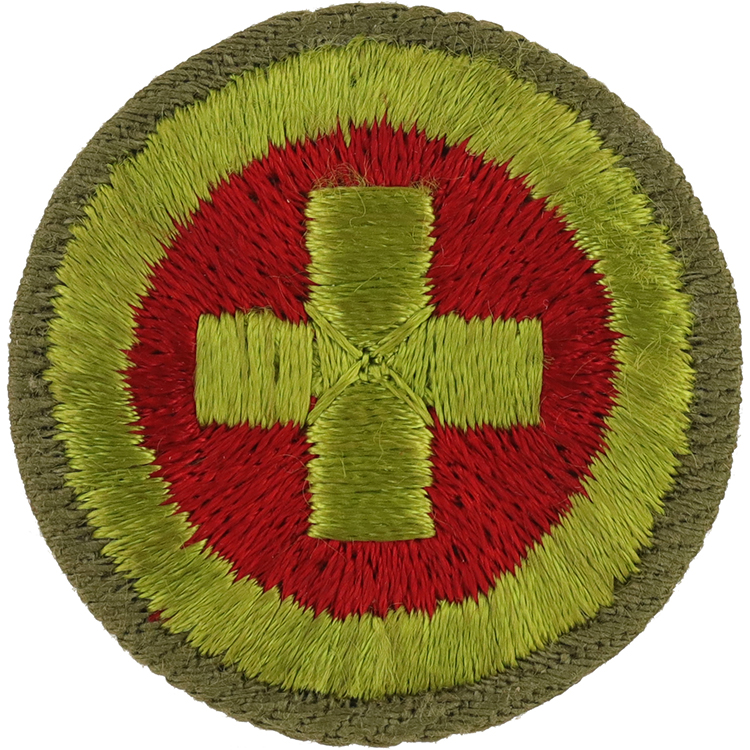
Fig. 1: FirAid-E2-Front
- Cloth: Khaki right twill
- Embroidery: Cotton lock stitch
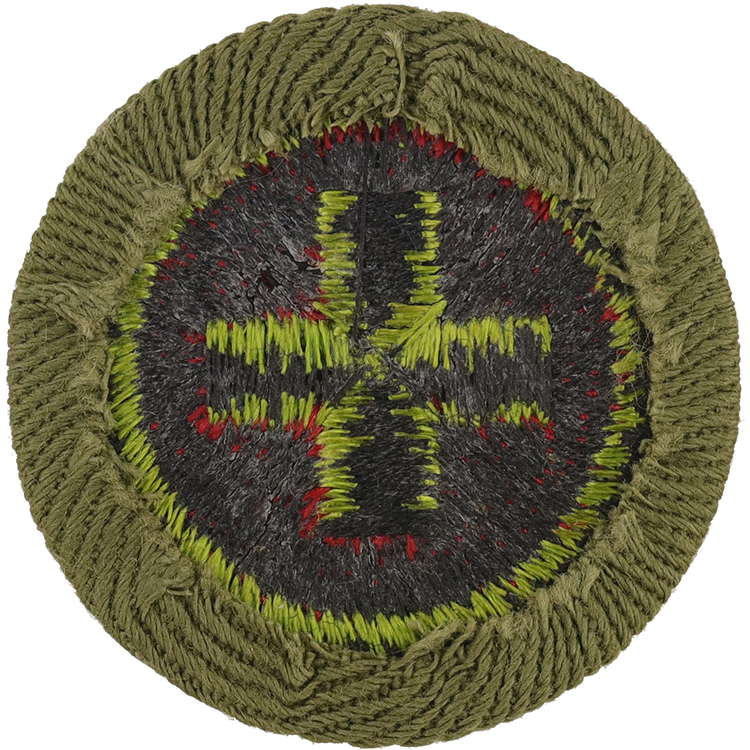
Fig. 2: FirAid-E2-Reverse
- Back: Black lock stitch, plain NO imprint with starch
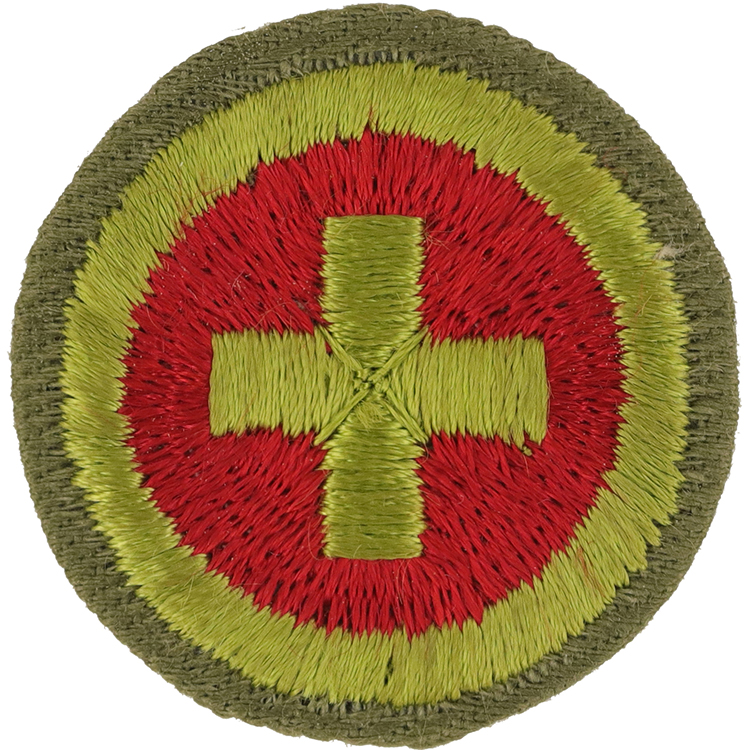
Fig. 3: FirAid-E2-mve1-front
- Minor variation: Narrow border
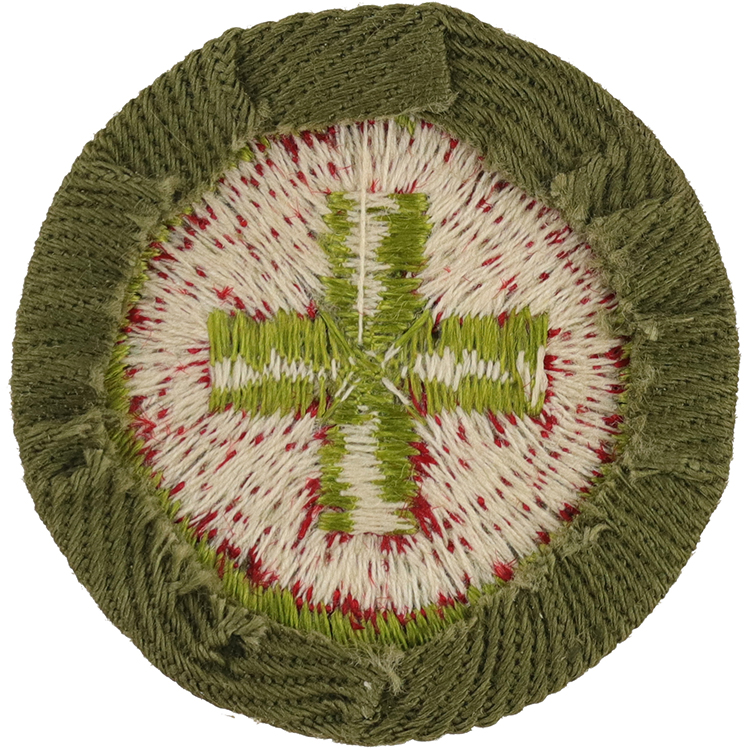
Fig. 4: FirAid-E2-mve1-reverse
- Minor variation: White lock stitch, plain NO imprint with starch
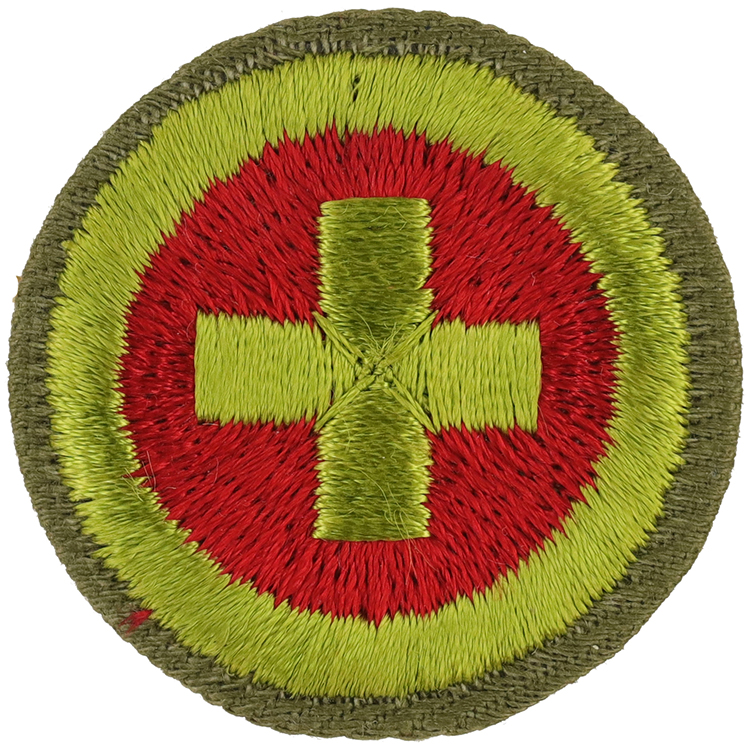
Fig. 5: FirAid-E2-mve2-front
- Minor variation: Narrow light border
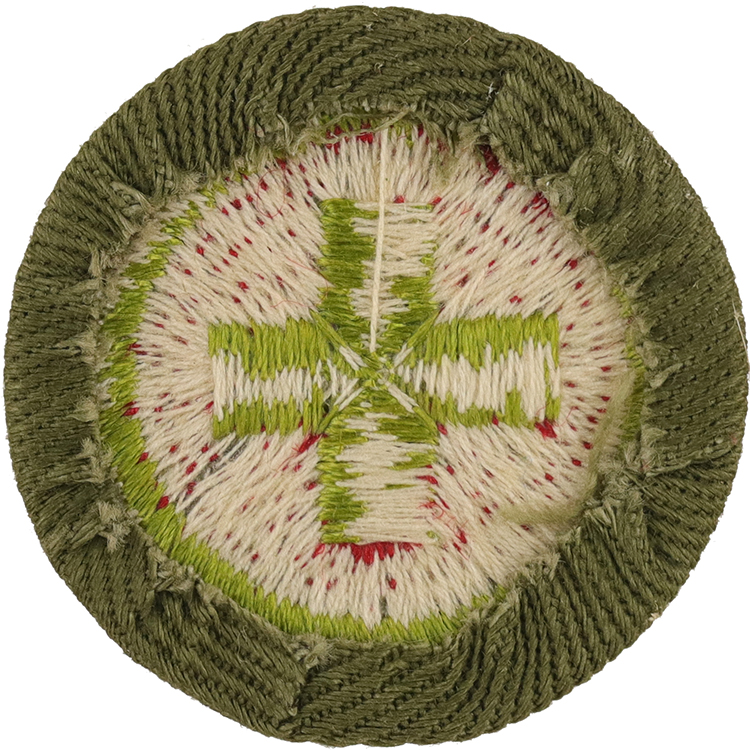
Fig. 6: FirAid-E2-mve2-reverse
- Minor variation: White lock stitch, plain NO imprint with starch
Item Name: First Aid 1947 - 1960
Item ID: FirAid-E2
Collector Rating: 1
Requirements December 1942 until April 1950
1. Review Second and First Class First Air Requirements, including demonstrations.
2. Show correct way to: (a) prepare for transporting a person with a compound fracture of the forearm; (b) make and apply splint for broken thigh.
3. Show how to: (a) stop bleeding from a ruptured varicose vein in leg; (b) control arterial bleeding on wrist and calf of leg simultaneously.
4. Explain what to do in the case of a man grasping, or otherwise in contact with an electric wire, or lying across the power rail of an electric railway.
5. Tell briefly what to do for a man found in a starving condition.
6. Show what to do in the case of a person who chokes from drawing water or food into his windpipe while eating.
7. Demonstrate with a small piece of cloth how he would sterilize and make safe a part of his shirt if he had to use it for an improvised dressing.
8. Tell what fatal disease germ is likely to be carried into a wound from a gun shot, knife thrust, rusty nail, pitchfork or garden rake, or from a powder burn; why the patient in every case must be taken to the doctor for a supplementary treatment.
9. Tell the dangers involved in the immediate transportation of an injured person where the extent of the injury is not known.
10. Explain what he would do if a companion dived into shallow water, and struck his head, staggered ashore and fell unconscious
11. Show treatment for extreme shock, using cover, correct position and heating devices.
*Available to Second Class Scouts who have met First Class First Aid Requirements, in addition to the five Badges allowed.
Requirements April 1950 until June 1952
1. Review Second and First Class First Air Requirements, including demonstrations.
2. Show correct way to: (a) prepare for transporting a person with a compound fracture of the forearm; (b) make and apply splint for broken thigh.
3. Show how to: (a) stop bleeding from a ruptured varicose vein in leg; (b) control arterial bleeding on wrist and calf of leg simultaneously.
4. Explain what to do in the case of a man grasping, or otherwise in contact with an electric wire, or lying across the power rail of an electric railway.
5. Tell briefly what to do for a man found in a starving condition.
6. Show what to do in the case of a person who chokes from drawing water or food into his windpipe while eating.
7. Demonstrate with a small piece of cloth how he would sterilize and make safe a part of his shirt if he had to use it for an improvised dressing.
8. Tell what fatal disease germ is likely to be carried into a wound from a gun shot, knife thrust, rusty nail, pitchfork or garden rake, or from a powder burn; why the patient in every case must be taken to the doctor for a supplementary treatment.
9. Tell the dangers involved in the immediate transportation of an injured person where the extent of the injury is not known.
10. Explain what he would do if a companion dived into shallow water, and struck his head, staggered ashore and fell unconscious.
11. Show treatment for extreme shock, using cover, correct position and heating devices.
Requirements June 1952 until June 1953
1. Review Second and First Class First Air Requirements, including demonstrations.
2. Show how to: (a) stop bleeding from a ruptured varicose vein in leg; (b) control arterial bleeding on wrist and calf of leg simultaneously.
3. Show treatment for extreme shock, using cover, correct position and heating devices.
4. Demonstrate with a small piece of cloth how he would sterilize and make safe a part of his shirt if he had to use it for an improvised dressing.
5. Tell what fatal disease germ is likely to be carried into a wound from a gun shot, knife thrust, rusty nail, pitchfork or garden rake, or from a powder burn; why the patient in every case must be taken to the doctor for a supplementary treatment.
6. Show correct way to: (a) prepare for transporting a person with a compound fracture of the forearm; (b) make and apply splint for broken thigh.
7. Tell the dangers involved in the immediate transportation of an injured person where the extent of the injury is not known.
8. Show what to do in the case of a person who chokes from drawing water or food into his windpipe while eating.
9. Explain what to do in the case of a man grasping, or otherwise in contact with an electric wire, or lying across the power rail of an electric railway.
10. Tell briefly what to do for a man found in a starving condition.
11. Explain what you would do if a companion dived into shallow water and struck his head, staggered ashore and fell unconscious.
Requirements June 1953 until January 1957.
1. Review Second and First Class First Air Requirements, including demonstrations.
2. Show how to: (a) stop bleeding from a ruptured varicose vein in leg; (b) control arterial bleeding on wrist and calf of leg simultaneously.
3. Show treatment for extreme shock, using cover, correct position and heating devices.
4. Demonstrate with a small piece of cloth how he would sterilize and make safe a part of his shirt if he had to use it for an improvised dressing.
5. Tell what fatal disease germ is likely to be carried into a wound from a gun shot, knife thrust, rusty nail, pitchfork or garden rake, or from a powder burn; why the patient in every case must be taken to the doctor for a supplementary treatment.
6. Show correct way to: (a) prepare for transporting a person with a compound fracture of the forearm; (b) make and apply splint for broken thigh.
7. Tell the dangers involved in the immediate transportation of an injured person where the extent of the injury is not known.
8. Show what to do in the case of a person who chokes from drawing water or food into his windpipe while eating.
9. Explain what to do in the case of a man grasping, or otherwise in contact with an electric wire, or lying across the power rail of an electric railway.
10. Tell briefly what to do for a man found in a starving condition.
11. Explain what you would do if a companion dived into shallow water and struck his head, staggered ashore and fell unconscious.
* A Second Class Scout must first qualify for First Class Scoutcraft requirement 1c (see page 110).
1. State what first aid is and why it is important.
2. Describe the causes and signs of shock. (b) Demonstrate on another person the first aid for shock.
3. Explain what should be done for severe bleeding. (b) Tell under what extreme circumstances the use of a tourniquet may be justified. (c) Demonstrate how to stop bleeding from a severe cut of the lower leg and wrist.
4. (a) State under what circumstances artificial respiration may be needed and explain how you can tell that a person has stopped breathing. (b) Demonstrate the back pressure-arm lift method of giving artificial respiration* for three minutes and additional first aid. (c) State what you can safely do to rescue a person from one of the following: contact with a live electric wire in a home, from a room containing carbon monoxide and other fumes or smoke, and from drowning.
5. (a) State how poisoning by mouth can be prevented. (b) Describe the first aid for poisoning by mouth and why quick action is necessary.
6. (a) Describe the signs of a broken bone and give general rules for first aid for fractures. (b) On a person lying down, and using improvised materials, demonstrate the first aid for any two of the following fractures: forearm, upper arm, wrist, collar bone, upper leg, lower leg, crushed foot.
7. (a) State the purpose of bandages and sterile dressings. (b) Demonstrate, using dressings when needed, the following bandages: (triangular) arm sling, foot, head; (cravat) eye, knee, hand.
8. (a) Tell the dangers in moving a seriously injured person. (b) If a sick or injured person must be moved, tell how you would decide what method to use. (c) Demonstrate alone and with assistance one carry for a mild injury and one for a serious injury.
9. (a) State the first aid for the following: sunburn, burn with blisters on the back of the hand, deep burn of the forearm, frostbitten ear or foot. (b) Demonstrate the proper way to extinguish flames on a person whose clothes are on fire and what you would do after the flames are out.
10. State some causes and proper first aid for unconsciousness. (b) Explain how to prevent simple fainting and describe first aid for simple fainting and epileptic convulsions.
11. (a) Describe proper first aid for one of the following: puncture wound, animal bite, poisonous snake bite, eye injury. (b) Explain what to do for one of the following: pain in the belly, blisters caused by rubbing, boils and pimples, colds, arm and leg cramps, bruises, earache, hiccup, choking on food, insect bites, tick bites, poison ivy.
12. (a) Make a list of materials to be included in a home first aid kit, first aid equipment for an automobile, or a patrol first aid kit. (b) Assist in teaching first aid (such as First Class first aid requirements to one or more persons).
* A Second Class Scout must first qualify for First Class Scoutcraft Requirement 1c (see page 110).
* Note: The old prone pressure method has been replaced by the newest back pressure-arm lift method.
Requirements January 1960 until September 1963
Second Class Scouts must meet First Class Scoutcraft Requirement 7 before attempting First Aid merit badge.
1. State what first aid is and why it is important.
2. (a) Describe the causes and signs of shock. (b) Demonstrate on another person the first aid for shock.
3. Explain what should be done for severe bleeding. (b) Tell under what extreme circumstances the use of a tourniquet may be justified. (c) Demonstrate how to stop bleeding from a severe cut of the lower leg and wrist.
4. (a) State under what circumstances artificial respiration may be needed and explain how you can tell that a person has stopped breathing. (b) Demonstrate the back pressure-arm lift method of giving artificial respiration* for three minutes and additional first aid. (c) State what you can safely do to rescue a person from one of the following: contact with a live electric wire in a home, from a room containing carbon monoxide and other fumes or smoke, and from drowning.
5. (a) State how poisoning by mouth can be prevented. (b) Describe the first aid for poisoning by mouth and why quick action is necessary.
6. (a) Describe the signs of a broken bone and give general rules for first aid for fractures. (b) On a person lying down, and using improvised materials, demonstrate the first aid for any two of the following fractures: forearm, upper arm, wrist, collar bone, upper leg, lower leg, crushed foot.
7. (a) State the purpose of bandages and sterile dressings. (b) Demonstrate, using dressings when needed, the following bandages: (triangular) arm sling, foot, head; (cravat) eye, knee, hand.
8. (a) Tell the dangers in moving a seriously injured person. (b) If a sick or injured person must be moved, tell how you would decide what method to use. (c) Demonstrate alone and with assistance one carry for a mild injury and one for a serious injury.
9. (a) State the first aid for the following: sunburn, burn with blisters on the back of the hand, deep burn of the forearm, frostbitten ear or foot. (b) Demonstrate the proper way to extinguish flames on a person whose clothes are on fire and what you would do after the flames are out.
10. State some causes and proper first aid for unconsciousness. (b) Explain how to prevent simple fainting and describe first aid for simple fainting and epileptic convulsions.
11. (a) Describe proper first aid for one of the following: puncture wound, animal bite, poisonous snake bite, eye injury. (b) Explain what to do for one of the following: pain in the belly, blisters caused by rubbing, boils and pimples, colds, arm and leg cramps, bruises, earache, hiccup, choking on food, insect bites, tick bites, poison ivy.
12. (a) Make a list of materials to be included in a home first aid kit, first aid equipment for an automobile, or a patrol first aid kit. (b) Assist in teaching first aid (such as First Class first aid requirements to one or more persons).
* The most practical method is mouth-to-mouth artificial respiration. Under certain conditions the manual chest-pressure arm-lift methods may be used.
7. BE PREPARED FOR ACCIDENTS
a. FIRST AID-Satisfy your examiner that you have retained your Second Class first aid knowledge. Improvise a sterile dressing. Use triangular bandage (Scout neckerchief) for arm sling as a binder for wounds on head, hand, knee, foot. Explain first aid for puncture wounds from splinter, nail, fishhook, dog bite, poisonous snake bite, heat exhaustion, sunstroke, frostbite. Explain danger of taking laxative for pain in stomach. Demonstrate first aid for fracture of collarbone, upper arm, forearm, lower leg.
b. TRANSPORTATION OF INJURED-Tell under what circumstances an injured person should or should not be moved. Demonstrate walking assist, one-man and two-man carries. Improvise a stretcher and, with helpers under your direction, transport a presumably unconscious person.







